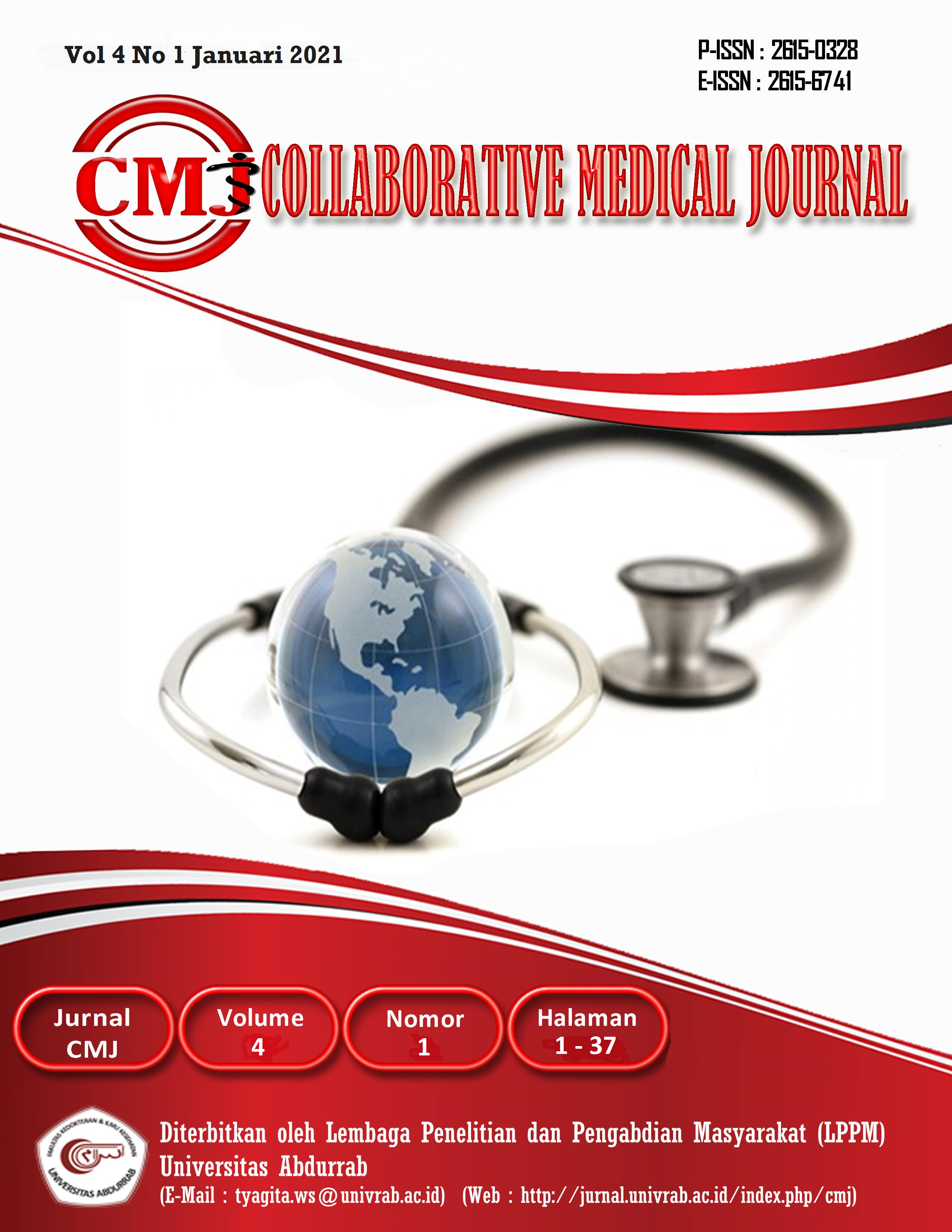ABSES HEPAR : SEBUAH LAPORAN KASUS
DOI:
https://doi.org/10.36341/cmj.v4i1.2138Keywords:
Abses hepar, piogenik, lobus sinistra, drainase, laparoskopiAbstract
Abses hepar adalah salah satu bentuk infeksi yang paling sering terjadi pada hepar. Salah satu bentuk abses hepar yang paling sering terjadi adalah abses hepar piogenik, yang umumnya ditemukan pada lobus kanan hepar. Kami melaporkan kasus abses hepar yang terjadi pada lobus kiri hepar, dengan keluhan yang tidak spesifik. Pasien datang hanya dengan keluhan perut yang membengkak, tanpa disertai keluhan lain. Pemeriksaan radiologis berupa CT-Scan mengkonfirmasi diagnosis abses hepar lobus sinistra. Pasien ditangani dengan tindakan drainase abses per laparoskopi. Tidak ada komplikasi yang ditemukan selama dan pasca operasi. Kasus ini menunjukkan bahwa diperlukan kecurigaan yang tinggi untuk abses hepar pada pasien dengan keluhan abdomen yang tidak spesifik. Drainase abses per laparoskopi yang dikombinasikan dengan terapi antibiotik merupakan pendekatan terapi yang aman dan efektif untuk kasus seperti ini.
Downloads
References
[2] A. Sharma, S. Mukewar, K. Mara, R. Dierkhising, P. Kamath and N. Cummins, "Epidemiologic Factors, Clinical Presentation, Causes, and Outcomes of Liver Abscess: A 35-Year Olmsted County Study", Mayo Clinic Proceedings: Innovations, Quality & Outcomes, vol. 2, no. 1, pp. 16-25, 2018, doi: 10.1016/j.mayocpiqo.2018.01.002
[3] J. Peris et al., "Clinical and Epidemiological Characteristics of Pyogenic Liver Abscess in People 65 Years or Older versus People Under 65: A Retrospective Study", BMC Geriatrics, vol. 17, no. 1, pp. 1-9, 2017, doi: 10.1186/s12877-017-0545-x
[4] C. Serraino et al., "Characteristics and Management of Pyogenic Liver Abscess: A European Experience", Medicine, vol. 97, no. 19, pp. 1-6, 2018, doi: 10.1097/MD.0000000000010628
[5] F. Reyna-Sepúlveda et al., "Epidemiology and Prognostic Factors of Liver Abscess Complications in Northeastern Mexico", Medicina Universitaria, vol. 19, no. 77, pp. 178-183, 2021, doi: 10.1016/j.rmu.2017.10.009
[6] W. Wang, Z. Tao and H. Wu, "Etiology and Clinical Manifestations of Bacterial Liver Abscess", Medicine, vol. 97, no. 38, pp. 1-4, 2018, doi: 10.1097/MD.0000000000012326
[7] S. Malekzadeh, L. Widmer, F. Salahshour, B. Egger, M. Ronot and H. Thoeny, "Typical Imaging Finding of Hepatic Infections: A Pictorial Essay", Abdominal Radiology, vol. 46, no. 2, pp. 544-561, 2020, doi: 10.1007/s00261-020-02642-z
[8] S. Sharma and V. Ahuja, "Liver Abscess: Complications and Treatment", Clinical Liver Disease, vol. 46, no. 2, pp. 544–561, 2021, doi: 10.1002/cld.1128
[9] S. Ghosh et al., "Clinical, Laboratory, and Management Profile in Patients of Liver Abscess from Northern India", Journal of Tropical Medicine, vol. 2014, pp. 1-8, 2014, doi: 10.1155/2014/142382
[10] O. Jolobe, "The special case of left lobe amoebic liver abscess", QJM: An International Journal of Medicine, vol. 112, no. 1, pp. 67-68, 2018, doi: 10.1093/qjmed/hcy148
[11] G. Khim, S. Em, S. Mo and N. Townell, "Liver abscess: diagnostic and management issues found in the low resource setting", British Medical Bulletin, vol. 132, no. 1, pp. 45-52, 2019, doi: 10.1093/bmb/ldz032
[12] W. Nan et al., "Differentiation of Liver Abscess from Liver Metastasis using Dual-Energy Spectral CT Quantitative Parameters", European Journal of Radiology, vol. 113, pp. 204-208, 2019, doi: 10.1016/j.ejrad.2019.02.024
[13] S. Choi, Y. Kim, J. Min, D. Cha, W. Jeong and W. Lee, "The Value of Gadoxetic Acid-Enhanced MRI for Differentiation between Hepatic Microabscesses and Metastases in Patients with Periampullary Cancer", European Radiology, vol. 27, no. 10, pp. 4383-4393, 2017, doi: 10.1007/s00330-017-4782-3
[14] G. Beckers, J. Magema, V. Poncelet and T. Nita, "Successful Laparoscopic Management of A Hepatic Abscess caused by A Fish Bone", Acta Chirurgica Belgica, vol. 121, no. 2, pp. 135-138, 2019, doi: 10.1080/00015458.2019.1658353
[15] T. Armstrong, S. Dluzewski and D. Yu, "Appendicitis with Direct Fistulation into the Liver: A Forgotten Cause of Pyogenic Liver Abscess", BJR|case reports, vol. 6, no. 4, p. 20200101, 2020, doi: 10.1259/bjrcr.20200101
[16] T. Pham Van, S. Vu Ngoc, N. Nguyen Hoang, D. Hoang Huu and T. Dinh Duong, "Ruptured liver abscess presenting as pneumoperitoneum caused by Klebsiella pneumoniae: a case report", BMC Surgery, vol. 20, no. 1, pp. 1-4, 2020, doi: 10.1186/s12893-020-00858-w
[17] S. Yu-Jang, L. Yen-Chun, L. Yu-Chia and Y. Yu-Hang, "Treatment and Prognosis of Pyogenic Liver Abscess", International Journal of Emergency Medicine, vol. 3, pp. 381-384, 2010, doi: 10.1007/s12245-010-0232-6
[18] M. Sarah Abbas and M. Abbas AR, "Laparoscopic Drainage of Liver Abscesses Case Report and Literature Review", East African Scholars Journal of Medicine and Surgery, vol. 1, no. 4, pp. 114-119, 2019, doi: 10.36349/easjms.2019.v01i04.003
[19] P. Hong Duc et al., "Laparoscopic Surgery for Intra-abdominal Ruptured Liver Abscess: A study of 32 cases", Open Access Journal of Surgery, vol. 10, no. 5, pp. 1-4, 2019, doi: 10.19080/OAJS.2019.10.555798
[20] S. Pais-Costa, S. Araujo and V. Figueiredo, "Hepatectomy for Pyogenic Liver Abscess Treatment: Exception Approach?", ABCD. Arquivos Brasileiros de Cirurgia Digestiva (São Paulo), vol. 31, no. 3, pp. 1-5, 2018, doi: 10.1590/0102-672020180001e1394
[21] M. Mogahed, A. Zytoon, B. Eysa, M. Manaa and W. Abdellatif, "Laparoscopic vs Open Drainage of Complex Pyogenic Liver Abscess", World Journal of Laparoscopic Surgery with DVD, vol. 13, no. 1, pp. 11-15, 2020, doi: 10.5005/jp-journals-10033-1395
Downloads
Published
Issue
Section
License
1. Copyright of all journal manuscripts is held by the Collaborative Medical Journal (CMJ)
2. Formal legal provisions to access digital articles of electronic journal are subject to the provision of the Creative Commons Attribution-ShareAlike license (CC BY-NC-SA), which means that Collaborative Medical Journal (CMJ) is rightful to keep, transfer media/format, manage in the form of databases, maintain, and publish articles.
3. Published manuscripts both printed and electronic are open access for educational, research, and library purposes. Additionally, the editorial board is not responsible for any violations of copyright law.
licensed under a Creative Commons Attribution-ShareAlike 4.0 International License.





